Gesture Recognition
Introduction
Gesture
- a movement usually of the body or limbs that expresses or emphasizes an idea, sentiment, or attitude
- the use of motions of the limbs or body as a means of expression
Automatic Gesture Recognition
- A gesture recognition system generates a semantic description for certain body motions
- Gesture recognition exploits the power of non-verbal communication, which is very common in human-human interaction
- Gesture recognition is often built on top of a human motion tracker
Applications
- Multimodal Interaction
- Gestures + Speech recognition
- Gestures + gaze
- Human-Robot Interaction
- Interaction with Smart Environments
- Understanding Human Interaction
Types of Gestures
Hand & arm gestures
- Pointing Gestures
- Sign Language
Head gestures
- Nodding, head shaking, turning, pointing
Body gestures
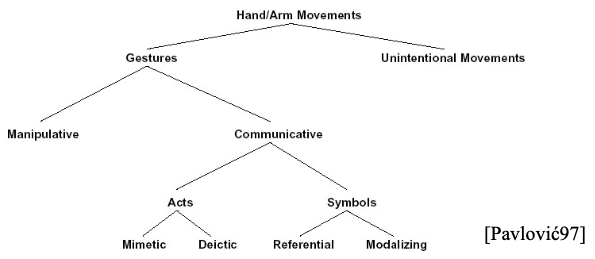
Automatic Gesture Recognition

- Feature Acquisition
- Appearances: Markers, color, motion, shape, segementation, stereo, local descriptors, space-time interest points, …
- Model based: body- or hand-models
- Classifiers
- SVM, ANN, HMMs, Adaboost, Dec. Trees, Deep Learning …
Hidden Markov Models (HMMs) for Gesture Recognition
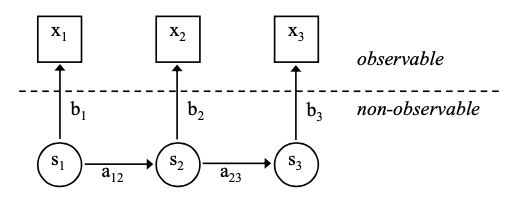
“hidden”: comes from observing observations and drawing conclusions WITHOUT knowing the hidden sequence of states
Markov assumption (1st order): the next state depends ONLY on the current state (not on the complete state history)
A Hidden Markov Model is a five-tuple
- : set of states
- : the initial probability distribution
- = probability of being the first state of a state sequence
- : the matrix of state transition probabilities
- : probability of state following
- : the set of emission probability distributions/densities
- : probability of observing when the system is in state
- : the observable feature space
- Can be discrete () or continuous ()
Properties of HMMs
For the initial probabilities:
- Often simplified by
For state transition probabilities:
- Often: for most except for a few states
When then are discrete probability distributions, the HMMs are called discrete HMMs
When then are continuous probability density functions, the HMMs are called continuous (density) HMMs
HMM Topologies
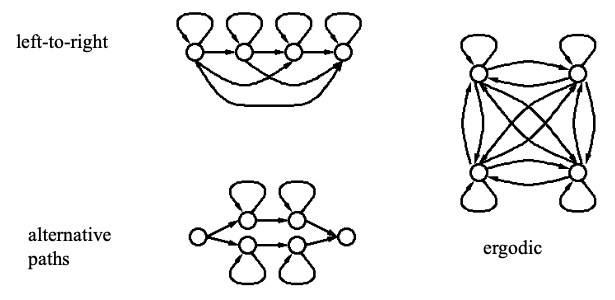
The Observation Model
Most popular: Gaussian mixture models
- : number of Gaussians (in state )
- : mixture weight for -th Gaussian (in state )
- : means of -th Gaussian (in state )
- : covariane matrix of -th Gaussian (in state )
Three Main Tasks with HMMs
Given an HMM and an observation
The evaluation problem
compute the probability of the observation
“Forward Algorithm”
The decoding problem
compute the most likely state sequence , i.e.
“Viterbi-Algorithm”
The learning/optimization problem
Find an HMM s.t.
“Baum-Welch-Algo”, “Viterbi-Learning”
Sign Language Recognition
- American Sign Language (ASL)
- 6000 gesture describe persons, places and things
- Exact meaning and strong rules of context and grammar for each
- Sign recognition
- HMM ideal for complex and structured hand gestures of ASL
Feature extraction
- Camera either located as a 1st-person and a 2nd-person view
- Segment hand blobs by a skin color model
HMM for American Sign Language
Four-State HMM for each word

Training
- Automatic segmentation of sentences in five portions
- Initial estimates by iterative Viterbi-alignment
- Then Baum-Welch re-estimation
- No context used
Recognition
- With and without part-of-speech grammar
- All features / only relative features used
ASL Results
Desk-based
348 training and 94 testing sentences without contexts
Accuracy:
- : #Words
- : #Deletions
- : #Substituitions
- : #Insertions
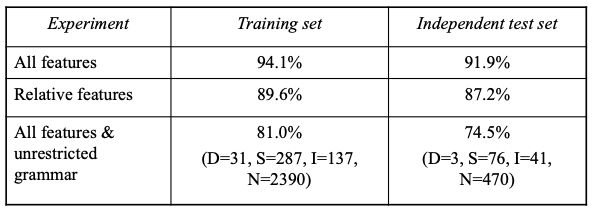
Wearable-based
- 400 training sentences and 100 for testing
- Test 5-word sentences
- Restricted and unrestricted similar!
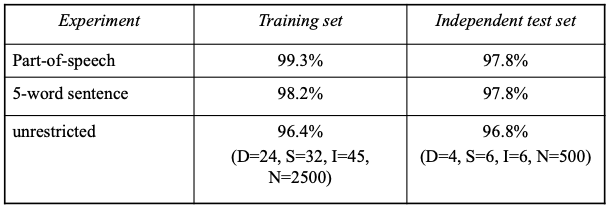
Pointing Gesture Recognition
Pointing gestures
are used to specify objects and locations
can be needful to resolve ambiguities in verbal statements
Definition: Pointing gesture = movement of the arm towards a pointing target
Tasks
- Detect occurrence of human pointing gestures in natural arm movements
- Extract the 3D pointing direction